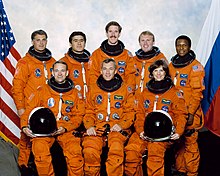STS-89
This article includes a list of references, related reading, or external links, but its sources remain unclear because it lacks inline citations. (May 2008) |
| COSPAR ID | 1998-003A |
|---|---|
| SATCAT no. | 25143 |
| End of mission | |

 | |
STS-89 was a space shuttle mission to the Mir space station flown by Space Shuttle Endeavour, and launched from Kennedy Space Center, Florida on January 22, 1998.
Crew
- Terrence W. Wilcutt (3), Commander
- Joe F. Edwards, Jr. (1), Pilot
- James F. Reilly, II (1), Mission Specialist 1
- Michael P. Anderson (1), Mission Specialist 2
- Bonnie J. Dunbar (5), Mission Specialist 3
- Salizhan Sharipov (1), Mission Specialist 4 - RSA
Launched and stayed on Mir
- Andrew S. W. Thomas (2), Mission Specialist 5
Landed and returned from Mir
- David A. Wolf (2), Mission Specialist 5
Crew Notes
STS-89 was originally scheduled to return Wendy B. Lawrence but returned David A. Wolf (Mir 24-25 / STS-86) and left Andrew Thomas on Mir. Thomas returned on STS-91.
Mission parameters
- Mass:
- Orbiter landing with payload: 114,131 kg
- Payload: 7,748 kg
- Perigee: 359 km
- Apogee: 382 km
- Inclination: 51.6.0°
- Period: 92.0 min
8th Mir docking mission
- Docked: January 24, 1998, 20:14:15 UTC
- Undocked: January 29, 1998, 16:56 UTC
- Time Docked: 4 days, 20 h, 41 min, 45 s
Mission highlights
The continuing cooperative effort in space exploration between the United States and Russia and a joint spacewalk will be the focus of NASA's first Shuttle mission of 1998 with the launch of Space Shuttle Endeavour on Mission STS-89. During the mission, more than 7,000 pounds (3,175 kg) of experiments, supplies and hardware are scheduled to be transferred between the two spacecraft.
This was the eighth of nine planned missions to Mir and the fifth one involving an exchange of U.S. astronauts. Astronaut David Wolf, who had been on Mir since late September 1997, was replaced by Astronaut Andrew Thomas. Thomas spent approximately 4 months on the orbiting Russian facility before returning to Earth when Discovery docked to Mir in late May during STS-91.
SPACEHAB Payloads include the Advanced X-Ray Detector (ADV XDT), the Advanced Commercial Generic Bioprocessing Apparatus (ADV CGBA), the EORF, Mechanics of Granular Materials (MGM) Experiment, Intra-Vehicular Radiation Environment Measurements by the Real-Time Radiation Monitor (RME-1312), Space Acceleration Measurement System (SAMS), VOA and the Volatile Removal Assembly prototype for the ISS Water Recovery System
In-Cabin Payloads include the Microgravity Plant Nutrient Experiment MPNE, the Shuttle Ionospheric Modification with Pulsed Local Exhaust (SIMPLEX), the Closed Equilibrated Biological Aquatic System (CEBAS), the TeleMedicine Instrumentation Pack (TMIP), Global Positioning System Development Test Objective (GPS DTO), the Human Performance (HP) Experiment, MSD, EarthKAM, Orbiter Space Vision System (OSVS) Shuttle Condensate Collection (RME-1331), the Thermo-Electric Holding Module (TEHM), the Space Linear Acceleration Mass Measurement Device (DSO 914), the Co-Culture Experiments (CoCult) and the Biochemistry of 3-D Tissue Engineering (BIO3D).
Get Away Special Experiments include the University of Michigan G-093 - Vortex Ring Transit Experiment (VORTEX), the German Aerospace Center and University Giessen G-141 - Structure of Marangoni Convection in Floating Zones Payload, the German Aerospace Center and the Technical University of Clausthal G-145 Glass Fining Experiment and the Chinese Academy of Sciences G-432 canister containing 5 crystal growth and material sciences experiments.
Mission insignia
The white inside line in the shape of the number eight and the nine stars of the insignia symbolize the flight's numerical designation in the Space Transportation System's mission sequence. The International Space Station is in the background.
See also
- Space science
- Space shuttle
- List of space shuttle missions
- List of human spaceflights chronologically



